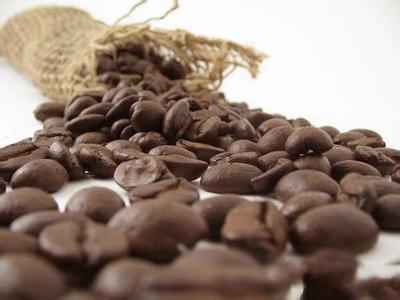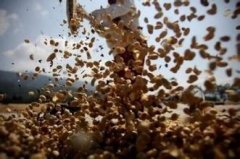The art of roasting coffee beans
Through the burning of the fire, release the aroma of coffee, sprinkle the personality of each fruit-- sour, sweet, bitter, incisively and vividly, from the insipid raw beans to the mellow aftertaste in the cup-- baking. it is the most important station for each coffee bean to outline its character and breed its fragrance during its long journey.

Whether in a professional roaster, on your own fire or in an oven, coffee beans have to go through a number of chemical changes, make three popcorn-like sounds and lose 15% of their moisture by 25% by weight during this 12-16-minute conversation with a temperature as high as 450F (℃).
Baking process, like popcorn full of fragrance and joyful bouncing sound. From raw beans, light and medium roasting to deep roasting, the water is released again and again, the weight is reduced, but the volume slowly expands, the color of the coffee beans deepens, the fragrant oil is gradually released, and the texture becomes crisp.
Have you prepared raw beans and decided to bake coffee beans with exclusive flavor? If not, you might as well use your imagination to follow us on this fragrant baking trip.
* Raw beans-each coffee cherry contains two raw beans, and the aroma is still deep in it, waiting to be discovered. In raw beans, there is a lot of chloric acid, which disappears with the baking process, releasing familiar and pleasant fruit acids such as acetic acid, citric acid, and malic acid found in wine. Baking is just right to present these beautiful sour tastes in moderation, while if you bake them too much, they will be completely masked.
When baked for 5-7 minutes, the beans begin to release water, changing from light green to orange, emitting the unique aroma of creamy roasted vegetables.
* shallow baking-when the beans make the first light sound, the volume expands at the same time, and the color changes to a delicious cinnamon color, so it is also called cinnamon roast or half-city roast. Acidity dominates the flavor of shallow roasted beans, texture and taste have not been brought into full play, so they are generally used as canned coffee, can not meet the real coffee experts.
* medium roasting-when roasted for 10-11 minutes, the coffee beans are elegantly brown. New Yorkers like to start each day by roasting coffee beans with fragrant milk and sugar at breakfast, so this method of baking is also called breakfast roast or city roast. Medium roasting can not only preserve the original flavor of coffee beans, but also moderately release aroma, so Blue Mountains, Colombia, Brazil. Wait for a single cup of coffee, choose this kind of baking method.
At 12-16 minutes, the oil begins to surface, and the beans are burned to a bright dark brown, called full-city roast. Some people think that the sour, sweet and bitter taste of coffee reaches the perfect balance, and the character of coffee beans is clearly carved out.
* Deep roasting-the darker the color of the coffee beans, the sweeter the flavor, when the oil has turned into caramel, it is bitter and has a long aftertaste, which is most suitable for brewing strong Espresso coffee, so it is also called Italian roasting.
Moderate roasting gives life to the coffee beans and turns into an intriguing sour, sweet and bitter taste. However, people who are sensitive to caffeine might as well choose deep-roasted beans as much as possible, because caffeine will slowly escape during roasting, so the deeper the roasted beans, the lower the caffeine content. It is said that the caffeine content in each cup of Espresso is only half that of other medium-roasted coffee.
Important Notice :
前街咖啡 FrontStreet Coffee has moved to new addredd:
FrontStreet Coffee Address: 315,Donghua East Road,GuangZhou
Tel:020 38364473
- Prev

Size, specification and grade of coffee beans
A, coffee can be divided into washing type and non-washing type according to specifications, and can also be divided into flat beans and round beans. Washing type: in the sink, after rubbing with water and utensils, the pulp and colloid are removed and dried, which is called washing coffee bean with uniform quality. Non-washing type: after the sun is naturally dried, the pulp and peel is removed by a sheller, and its quality is unstable. The fruit of coffee is made up of two oval shapes
- Next

Coffee Bean Processing
The coffee tree has a pair of oval seeds in the center of the fruit. The seeds are covered by the outer skin, endocarp and pulp. Mature fruit will rot in a short time without treatment, so the purpose of refining is to make coffee beans long-term preservation, easy storage and circulation.
Related
- Guji coffee producing area of Guji, Ethiopia: Humbela, Shakiso, Wulaga
- What is the most expensive variety of Qiloso in BOP multi-variety group?
- How to store the coffee beans bought home?
- Why are Yemeni coffee beans so rare now?
- Ethiopian Sidamo all Red Fruit Sun Sun Santa Vini Coffee beans
- SOE is mostly sour? What does it mean? Is it a single bean? what's the difference between it and Italian blending?
- Is Italian coffee beans suitable for making hand-brewed coffee?
- How to choose coffee beans when making cold coffee? What kind of coffee beans are suitable for making cold coffee?
- Just entered the pit to make coffee, what kind of coffee beans should be chosen?
- Can only Japan buy real Blue Mountain Coffee? What are authentic Jamaican Blue Mountain coffee beans?

